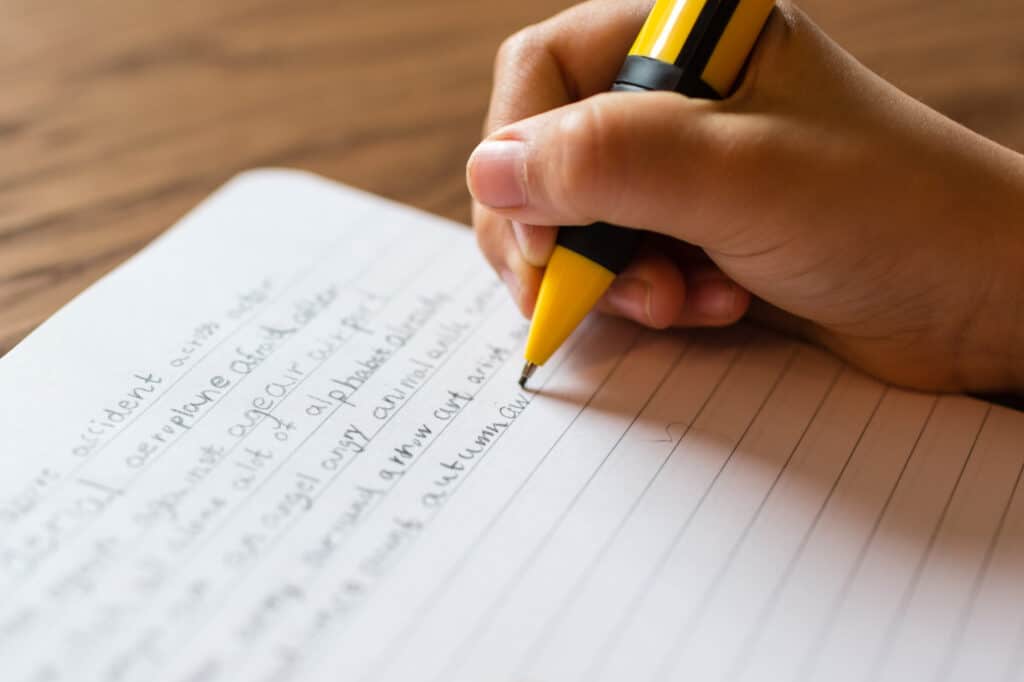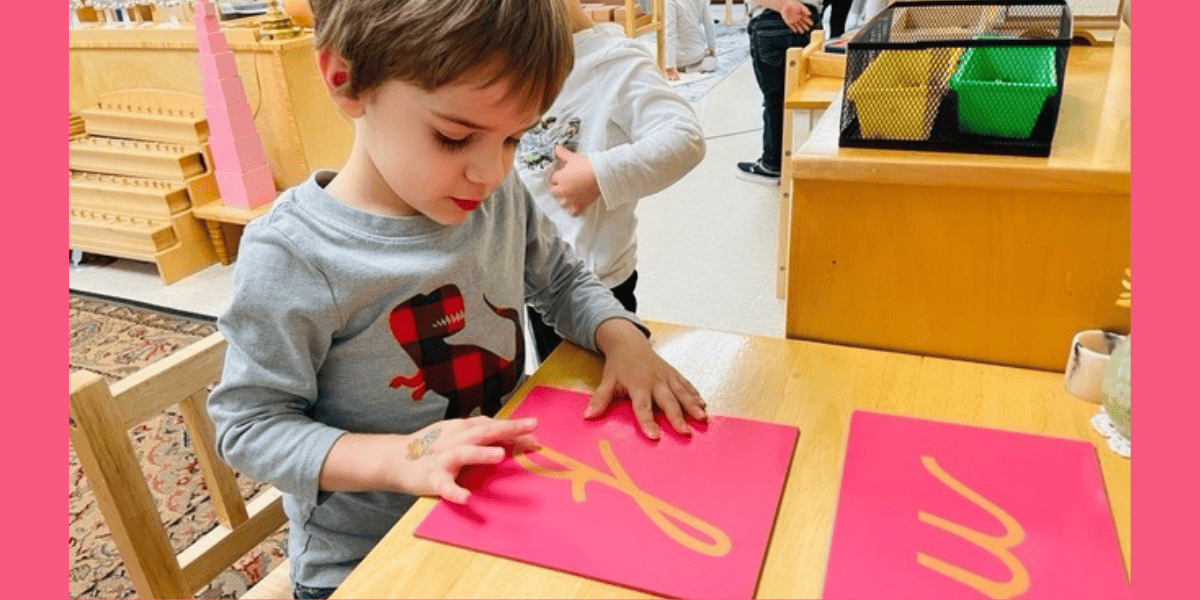“Handwriting is more connected to the movement of the heart.”
~Natalie Goldberg, American author and speaker
By Tracy Reilly
It’s no secret that screen time has gotten out of control for adults and kids alike. The pandemic exacerbated what was already a shift to increasing education via computer. You might agree: There’s value in kids learning and getting comfortable with technology. With job opportunities in the tech space growing strong, and companies expecting employee fluency in computer programs and skills, continuing in this direction is inevitable. But does replacing pencils with keyboards shortchange your kids in other foundational ways? Research on handwriting’s impact on the brain argues it does.
If you live in one of the 17 states that require students to learn cursive (characters joined in a flowing fashion), count your kids lucky. California just passed a bill this year to become the 18th. Why the shift back to pencil and paper? One appeal is historical: Think of old love letters between your parents or grandparents, letters from grandparents to grandchildren, and family records or historical genealogical documents. If your kids don’t learn how to at least read cursive, how will they be able to decipher such precious mementos?
On a more civic note, if generations gradually stop reading and writing cursive, you’d need to hire an expert for such fundamental things as reading the Declaration of Independence, Bill of Rights, and the Constitution. Of course, they’re accessible in printed text, but if kids seeing the actual Constitution in the National Archives Museum, and being unable to read it doesn’t sit well with you, you’re not alone.
Speaking about her 2022 essay, “Gen Z Never Learned to Read Cursive,” historian Drew Gilpin Faust stressed the importance of having the ability to read documents yourself, while not having to rely on a translator’s interpretation:
“When we can’t read documents from the past, then the past is presented to us indirectly . . . Just imagine if you had some kind of contract that you had signed and you couldn’t read it and someone told you, well, this is what’s in the contract . . . And then later you might find that it was something else.”
Setting aside the historical, nostalgic aspects, the more tangible benefits to your child have nothing to do with the past, but rather, their present brain development. Researchers have found there are numerous and varied advantages to writing by hand rather than a computer, and it doesn’t only apply to cursive.
Something as simple as jotting down a grocery list is actually a complex feat to learn. While handwriting was long thought to merely be a maneuver of fine motor skills, it turns out when you move your hand to create letters, that particular motion exercises far more than your physical skills.
Even your child’s first attempts at letter writing are more valuable than you might think. According to psychologist and Indiana University researcher Karin James, “When a kid produces a messy letter, that may help him learn it.” In other words, variability in handwriting letters can actually be beneficial to learning.
She continues:
“Our brain must understand that each possible iteration of, say, an “a” is the same, no matter how we see it written. Being able to decipher the messiness of each “a” may be more helpful in establishing that eventual representation than seeing the same result repeatedly.”

Impact on Learning
Johns Hopkins scientists observed handwriting’s effect on learning when they divided 42 adults into three groups—one using videos, one using keyboards, and one using pen and paper—to teach them the Arabic alphabet. All 3 groups successfully recognized the new letters, but the handwriting group achieved proficiency in just 2 sessions; the keyboard and video groups took 6.
Perhaps more important, after learning the Arabic alphabet, participants’ ability to actually use the new letters—by writing them, spelling words, or using them to decipher unfamiliar words—was tested, and the handwriting group again surpassed the other two.
According to the researchers, when it comes to writing by hand:
“[This] provides a perceptual-motor experience that unifies what is being learned about the letters (their shapes, their sounds, and their motor plans), which in turn creates richer knowledge and fuller, true learning . . . With writing, you’re getting a stronger representation in your mind that lets you scaffold toward these other types of tasks that don’t in any way involve handwriting.”
So when your child writes by hand, their brain is being primed for learning. Norwegian neuropsychology professor Audrey van der Meer, and colleagues found this to be true in a study of 12-year-olds and young adults, where they compared cursive handwriting, drawing, and typing. Like the Johns Hopkins scientists, when participants wrote by hand, they found electrical activity in brain regions important for memory and encoding of new information.
Handwriting, as well as drawing, also synchronized theta brain waves—slow waves that typically occur when you’re drifting off to sleep, or when you’re awake but deeply relaxed. Theta waves are believed to be important for processing information and making memories—an ideal state for learning.
Van der Meer emphasized the value of handwriting compared to typing:
“A lot of senses are activated by pressing the pen on paper, seeing the letters you write and hearing the sound you make while writing. These sense experiences create contact between different parts of the brain and open the brain up for learning. We both learn better and remember better.”
Most college students, and many kids as young as middle school, now take notes on laptops rather than by hand. If your kid is one of them, there’s good reason to reconsider this method. Researchers from Princeton and UCLA published findings from three studies they did comparing “longhand” note taking (handwriting) versus note taking on a laptop.
In the first study, they compared participants who watched a short lecture and took notes via writing or typing, and were then tested on the material directly following the lecture. When asked factual questions (e.g. “Approximately how many years ago did the Indus civilization exist?”), there was little difference between the two methods, with laptop notetakers achieving slightly better scores. However, when it came to conceptual questions (e.g. “How do Japan and Sweden differ in their approaches to equality within their societies?”), those who took notes by hand markedly outperformed the laptop group.
Not surprisingly, given the speed typing allows, the laptop notetakers had a much higher rate of verbatim notes. What was surprising was that the verbatim notes actually had an inverse effect on scores—the greater the amount of verbatim notes, the lower the score. This effect was negligible on the factual questions, but substantial on the conceptual ones. The scientists believe this is because verbatim note-taking utilizes “shallow cognitive processing”—you may be catching the words, but your brain is focused on copying them correctly rather than understanding them.
The Princeton-UCLA team repeated the experiment with a different batch of participants, separating them into four groups: two longhand; two laptop. This time, they administered the test a week after the lecture, and they allowed one longhand group and one laptop group to study their notes for ten minutes prior to the test. Under this method, the longhand group given time to study their notes outperformed all three of the other groups.
Why would using pen and paper help you when it’s generally a slower method of note taking? Researchers believe that it’s actually that lack of speed that helps. When taking notes by hand, mindless verbatim note-taking goes by the wayside, and instead, you’re forced to process the incoming information in order to write it down in a concise way. In doing so, you’re essentially studying as you take notes. Because your brain has already worked to process the information in order to summarize it, when given a chance to review notes, your mind and memory already have a head start.
If you have a younger child, handwriting can prove even more valuable. In a study where pre-literate kids were asked to reproduce a letter of the alphabet by tracing over a dotted outline, drawing the letter on a blank page, or typing it on the computer, children who drew the letter freehand activated a unique “reading circuit” in the brain—a result not shown in the tracing or typing groups. According to the study’s authors:
“These findings demonstrate that handwriting is important for the early recruitment in letter processing of brain regions known to underlie successful reading. Handwriting, therefore, may facilitate reading acquisition in young children.”
At Montessori
The benefits of writing with good ol’ pencil and paper are further enhanced when kids learn cursive. Much like printing and tracing result in different neurological activation, the effects of cursive and printing can differ in your child’s brain and development. So aware of this are Montessori schools that they actually teach cursive first, before printing.
According to Montessori theory, the circles and straight lines that make up the majority of printed letters are the hardest motions to master. Cursive lends itself to more forgiveness this way as the writing is fluid and its loops allow for imperfections while maintaining legibility.
If you’ve ever seen your child use their finger next to the pencil as she writes, measuring out spaces between letters, you know the kind of focus and patience printing can require. Cursive, on the other hand, flows from letter to letter, avoiding ambiguity and confusion when it comes to spacing, as it’s clear where one word ends and another begins.
Kia Hammill, a 15-year Montessori educator, has observed hundreds of children using cursive as their entry into writing. This is what she said about it:
“The flowing movement of cursive is so much more natural than the halting motions of print. It’s much better for strengthening fine motor skills. There’s also the aspect of pride and respect about having beautiful handwriting.”

Mind Your Ps and Qs
Along with improved motor skills, more effective communication, and increased confidence, cursive also has the benefit of more distinct letter formations. In print, your child can easily confuse a “d” for a “b” or a “p” for a “q.” In cursive, those letters are distinct enough that educators and therapists actually use it as a technique in the treatment of dyslexia.
While some states and schools are catching up on this science, and the importance of handwriting, if yours is not one of them, you might consider broaching the subject with other parents, and going to your school board with research to support the case for cursive.
In the meantime, you can introduce and encourage cursive on your own with workbooks, or for the younger learners, Montessori-style by tracing sandpaper letters, or another tactile medium. Teaching your child good writing posture (feet on the floor, elbows on the desk) and paper placement (a 45-degree angle from the writing arm while the opposite hand anchors the top of the paper) can help, too.
For your older kids, obviously computers remain an important tool, but van der Meer applies nuance, “I would use a keyboard to write an essay, but I’d take notes by hand during a lecture.”
As for your own use, next time you’re heading to the store, grabbing a pen and paper to jot down your shopping list could prove helpful. It might just prevent you from walking out of the store with a bagful of groceries, while forgetting the main item you actually went in for.
~
Published on December 14, 2023.
To contact A Voice For Choice Advocacy, please email media@avoiceforchoice.org.
If you would like to support the research and health education of AVFC editorial, please consider making a donation today. Thank you.

